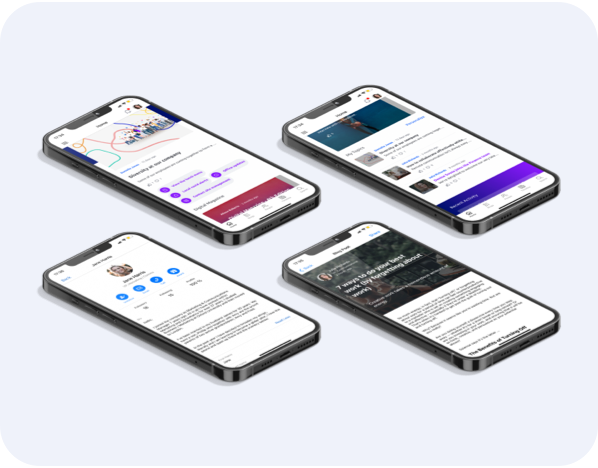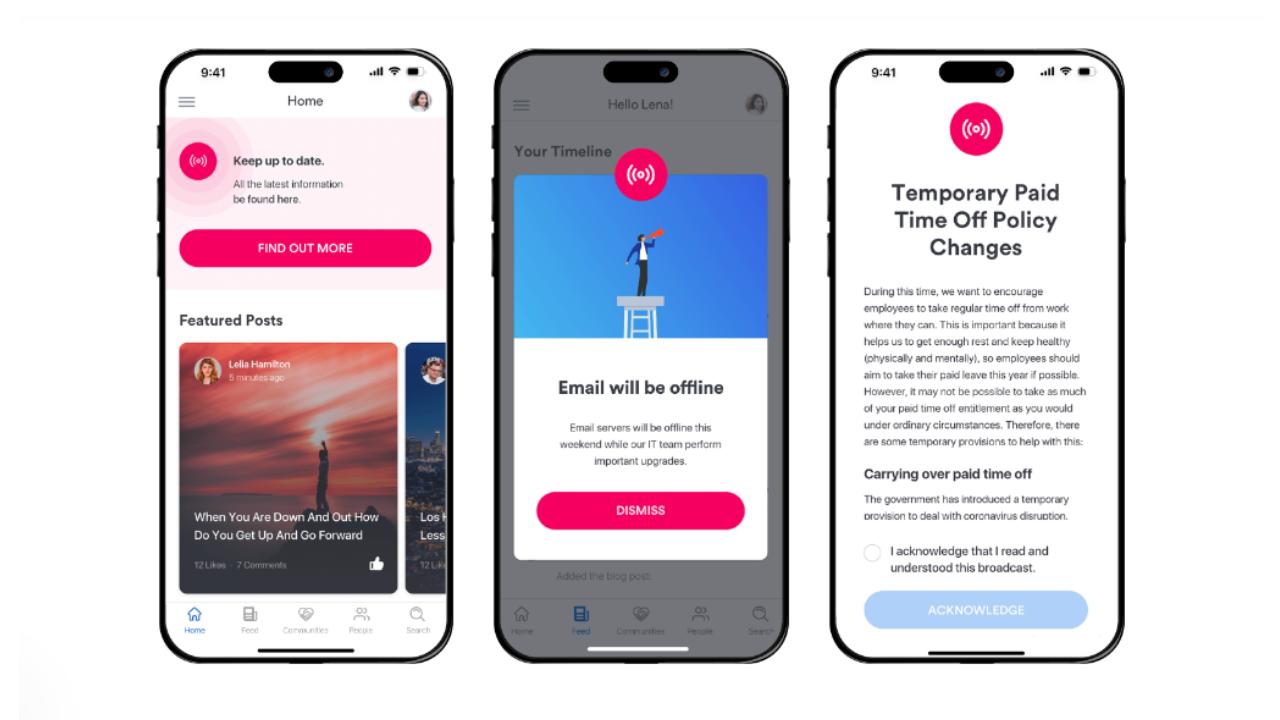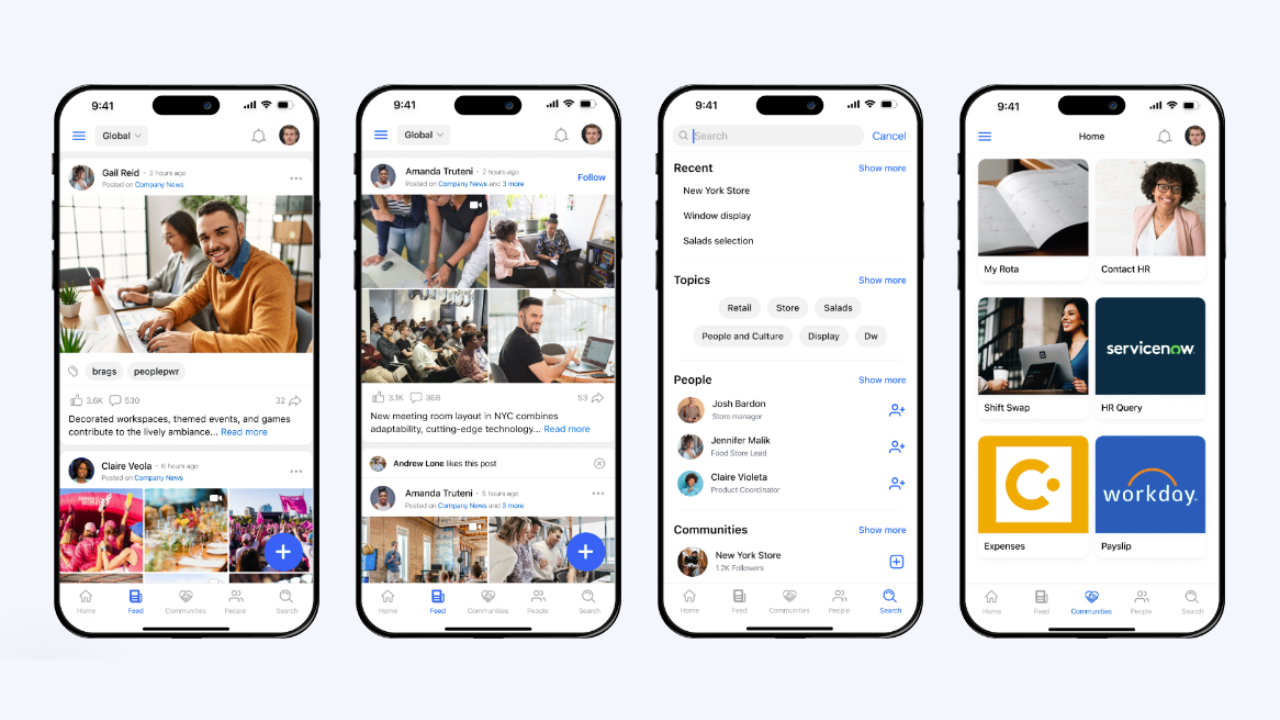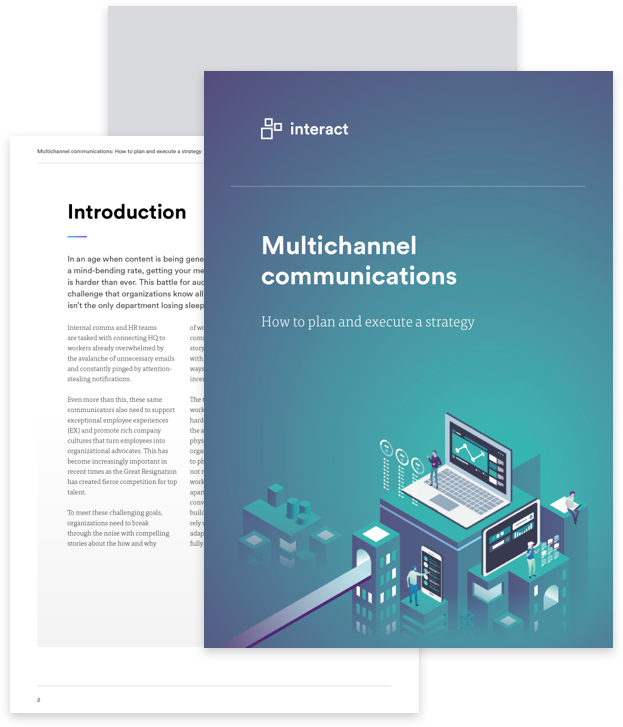Employee mobile apps are becoming a game-changer for businesses in today’s mobile-first world. In this article, we explore the benefits and considerations of making your digital workplace mobile accessible.
Whether frontline, hybrid, remote, or office-based, your team members should all have somewhere they can collectively call home.
An employee mobile app such as a mobile intranet will enable your entire workforce – including members who are on the go far more often than they are at a desk – to instantly access the tools and information they need from a shared digital headquarters.
It’s about meeting your workers where they’re reliably spending their time and attention, regardless of where they’re clocking in from.
As of 2024, 4.88 billion people – more than 60% of the global population – own at least one smartphone; in the U.S., nine in 10 own one. And they’re not afraid to use it: recent research shows that people spend an average of 4.8 hours a day on their phone. In the U.S., that translates to checking their device close to 150 times.
Table of contents
- Now’s the moment for mobile
- Close the gap with an employee mobile app
- Empower everyone – especially those on the frontlines
- Seeing – and seizing – the possibility
- Shaping your employee mobile app strategy
- Selecting the right partner
- Sticking the launch of your employee mobile app
- Making your employee mobile app mint
Now’s the moment for mobile

As the future of work takes shape today, the moment’s especially ripe for mobile. Growing global and gig work means your messages must reach teams stretching across time zones, languages, and affiliation types. Digital natives, joining the workforce in droves, are bringing with them new communication norms. And the headwinds of the past few years – a global pandemic, civil rights reckonings, and geopolitical strife – are forcing purposeful work into focus.
In short, the need for transparent, timely, and inclusive communication has never been greater – or likelier to make or break your business: According to Gallup, employees who get enough information on goals and successes are 2.8 times more likely to be engaged, and business units with engaged employees are 23% more profitable.
But the vast majority of employers are failing to keep up: Just 7% of workers strongly agree that communication in their workplace is open, accurate, and relevant (Gallup again).
Close the gap with an employee mobile app

Smartphone usage isn’t just for off-the-clock.
In a 2021 survey of 1,500 workers, 62% said mobile devices improved their productivity, and a 2020 study found that social media usage at work – like the kind enabled by company-created apps – contributes to positive two-way communication for 80% of workers.
In this way, employee mobile apps are a powerful extension of your intranet or EX software that can:
- Help senior leaders and IC teams distribute business news, events, and policy updates through features like push notifications that alert staff to critical information in the moment of need (e.g., an upcoming open-enrollment deadline or ongoing developments in an emergency)
- Foster social interaction and cohesion through blogging, liking, sharing, and commenting
- Create a one-stop shop for core tools, processes, policies, documents, and other information that your employees use the most, all quickly discoverable with built-in intelligence and enterprise search functionality
- Enable dispersed employees to find and connect with co-workers through search functionality and a comprehensive people directory
- Balance access and cybersecurity needs for the growing contingent of contract and gig workers who may not have a company email address or be able to get behind your firewall to access your intranet from their computer
Empower everyone – especially those on the frontlines
As hybrid and remote work remains in vogue, a mobile app can keep your employees connected to each other and your mission, no matter where they are.
It’s an urgent priority for leaders: According to Owl Labs, more than a third of managers (34%) who lead remote or hybrid teams cite maintaining cultural connection, team camaraderie, and communication as a top concern; almost as many (32%) say the same of employee engagement.
Fostering this cohesion is especially important for your deskless frontline.
Multichannel communications: How to plan and execute a strategy
Although 80% of workers around the world are deskless – meaning they’re on the factory floor or hospital ward or open road delivering your services, making your products, and dealing with your customers – this group receives just 1% of enterprise software funding.
Failing to invest in the experiences of this critical contingent is a missed opportunity: Research suggests organizations with a more engaged frontline can see customer loyalty rates that are 12% higher than competitors’.
Mobile apps can help bring about this win. With workers always on the go, smartphones are the one device that’s readily on hand.
Seeing – and seizing – the possibility

Employee mobile apps can boost business-critical engagement among employees of all stripes by helping you face the forces shaping the future of work head on.
Radiate shared values
Because mobile apps bring about broader access to tools and resources, they can reinforce your organization’s commitment to inclusion and other top values of today’s workers – something that’s increasingly important to keeping them around.
According to Gallup, only 27% of U.S. employees strongly believe in their organization’s values, and less than half even know what those values are. This disconnect can lead to checking out: One in five employees feels disengaged from their work when they aren’t connected to the company or culture, Owl Lab says.
In contrast, mobile app features like customizable content creation and notification tools can emphasize your commitment to connectivity and inclusivity by allowing you to translate your comms into the most appropriate language for each employee and ensuring they receive it at the right time of day (or night).
Foster in-the-moment learning and collaboration
According to Owl Labs, nearly half (48%) of hybrid workers believe they’re missing out on impromptu feedback and development that could hamper their career growth – and 68% of managers believe their teams are missing out on these career-defining opportunities. The antidote, according to the research, is adding or enhancing employee learning and development offerings.
Multichannel communications: How to plan and execute a strategy
A mobile app can connect deskless and distributed employees to opportunities through features like a comprehensive knowledge base of courses and materials to help them learn on the fly, a searchable directory of in-house experts to call up at a moment’s notice, and lively discussion forums that allow them to crowdsource precise solutions to their queries.
Streamline and save on comms
In the U.S. alone, inefficient communications cost organizations $2 trillion per year in time and productivity, according to Axios HQ.
Potential culprits include:
- Arduous comms creation: Axios HQ saysleaders spend three to 10 hours per week preparing essential communications for employees.
- Disorganized internal systems: Research shows that employees spend 20% of their time on average searching for information they need to do their jobs.
- Unruly email: An employee spends up to 23% of their workday on email, sending and receiving an average of 112 emails throughout it.
- Compounding losses: All that fruitless searching and taming of email overgrowth can add up: Recent research suggests communication barriers lead to delays or failures in project completion (44%), missed goals (25%), and lost sales (18%).
Mobile apps with personalization features like user groups and Geofences can ensure the right messages reach the right people at the right time, without adding undue noise or development burden. For their part, customizable push notifications make sure that users are kept in the loop on the things that matter most.
Shaping your employee mobile app strategy
To realize the huge potential of an employee mobile app, you must ensure it’s an integrated, additive tool from day one. And that takes upfront planning.
Consider:
- Why do we need an app?
- Who will use the app?
- Where does the app fit in our digital workplace?
- How do we design winning app journeys and experiences?
- What’s our app intranet identity and brand?
Use your multichannel strategy as your North Star
To start, map out how a mobile app fits into your multichannel communication strategy. Depending on your circumstances, your channels may already include mobile, web, email, integrations, digital signage, and more.
Pay particular attention to how the app will fit together with any existing mobile elements, such as SMS, intranet access via web browser, and third-party messaging platforms. As an example, app-driven SMS and push notifications might fill a gap in reaching deskless workers who don’t use Teams or Slack.
Multichannel communications: How to plan and execute a strategy
Consider plotting out the components of your strategy against your key employee groups or personas. It may look something like this:
Once you’ve defined which groups would most benefit from a mobile app, consider which messages are best conveyed there (e.g., routine updates, urgent broadcasts, or both) and when you’ll send notifications for workers in different countries or on divergent shift patterns.
Also consider which initiatives, campaigns, or other use cases – both current or prospective – might benefit from a mobile component. As an example, an internal communications campaign to unveil a refreshed brand identity might start with a Vlog video series from stakeholders leading the rebrand project, then branch out with:
- A company-wide newsletter that recaps updates in text and images
- App notifications encouraging deskless users to view new videos on their mobile devices
- Written blogs linked to videos to generate likes, comments, @mentions and other social activity
- Teams or Slack alerts when new videos are uploaded
- QR codes embedded in digital signage messages that take location-based workers to videos
Design with users in mind (and in the driver’s seat of your mobile employee app)
Based on your strategic mapping, identify your top personas for your employee mobile app, and start designing with their needs in mind.
Deskless workers, for example, might need features that allow them to:
- Take paid time off
- Access payroll and tax information
- Enroll in health insurance and other benefits
- Complete employee surveys and performance review processes
- Take learning courses
- Onboard to a new job
- Stay informed via company communications
- Access policy information and connect with HR
- Customize their own experience, including how, when, and about what they’re notified
- Complete managerial tasks for anyone they lead, such as conducting reviews, coordinating time and scheduling, and monitoring PTO and other essential HR approvals
During the app development process, build in lots of opportunities for workers to offer feedback through surveys, polls, conversations, and other avenues. It’s a win-win: You’ll ensure you’re meeting your people’s needs by getting input straight from the source, and they’ll be likelier to buy in to the thing they helped build. What’s more, you can play up that ‘designed by you, for you’ point in your internal marketing for the app.
Selecting the right partner

Once you’ve shaped your mobile app strategy, the next step is finding a partner to help you achieve your vision. Ahead, some enablers to keep in mind as you’re vetting vendors.
A delightful employee mobile app UX
Find a partner that can help you create a thing of beauty. It’s not a superficial consideration when 52% of users don’t return to an app because of its aesthetics.
Of course, you should consider both form and function, starting with a strong foundation.
A native app that’s created specifically for a mobile operating system (iOS or Android) is often optimal compared to web and hybrid options because it’s fast, reliable, secure, and able to make best use of a device’s features.
Beyond how the app is built, ask prospective partners for their perspective on the following UX considerations:
- Parity: Mobile users should have access to the same level of intranet functionality as those who are accessing it from computers. As an example, because Interact’s employee app is built natively, mobile-first users receive the same homepage experience as they would with the desktop platform.
- Mobile-responsive design: This optimizes your intranet to look great when accessed via a browser on an employee’s smartphone or tablet.
- Complementary digital signage: When an employee scans a QR code, it should direct them to in-app intranet content relating to the information that signage displays.
By delivering a seamless experience that transfers from web to app, your organization can communicate to remote, in-office, and on-location staff alike that their app will be an artful blend of form and function.
Social savvy
In 2016, Pew found that nearly one in four workers uses social media while on the clock to make or support personal connections. Almost as many use it to get information that helps them solve problems at work (20%), build or strengthen personal relationships with coworkers (17%), and/or ask work-related questions of people within or outside of their organization (12%).
Multichannel communications: How to plan and execute a strategy
Since Pew published this seminal research, social platforms and usage has only proliferated, meaning your workers are both better versed and more expectant when it comes to workplace offerings that foster connection to your mission and each other.
To put social and your superfans to work for you, ensure your app development partner prioritizes in-app features like the following:
- An in-house expert directory that brings your people together, no matter where and how they work. Ideally, users should be able to search a variety of criteria, including expertise, location, and role, then call or message their chosen SME directly using the app.
- Content creation toolsthat allow your people to create on the go and at the precise moment inspiration strikes.
- Social advocacy features that make it easy for employees to share insights, job openings, and other brand-building content to their external networks.
- An employee recognition program that rewards good behavior, like championing company values, with points that can be redeemed for gifts and distinctions.
- Forums, discussion boards, and communities of practice that giveemployees a place to connect over specific themes, challenges, or interests – and surface internal influencers who are answering questions and generating more discussions.
- Social intranet functionality that makes your platform sticky and keeps your people coming back. Think @mentioning, #hashtagging, image-friendly newsfeeds, forums, commenting, sharing, and gamification.
Powerful workplace search
An ‘everywhere’ mobile intranet that truly serves your employees’ needs should be more than a communications platform. It should also serve as a knowledge base containing everything from policies and procedures to people directories, support, FAQs, and access to tools for everyday tasks.
An intelligent enterprise search tool should be there to tie it all together and help your people find what they need fast.
Your mobile-first users should enjoy this same functionality.
As an example, Interact allows users, regardless of where they’re logging in from, to refine searches by author, content type, associated topics, classifications, confidentiality ratings, and even file type of any attachments included on a page.

Domino’s Interact-powered PieNet intranet enables team members spanning more than 18,000 stores to find vital resources, guides, documents, and operating procedures on the fly as they’re flipping pies and taking names. That’s largely thanks to the accompanying mobile app’s powerful enterprise search, which mirrors the web experience.
Today, PieNet is attracting 5,000 active users – including 75% of U.S. franchisees and 60% of corporate above-store team members – every week.
More heavy hitters
Other capabilities to discuss with prospective vendors include:
- Personalization tools, such as custom homepages and workplace tools, targeted content, location-based information and updates through geofencing, employee groups based on persona criteria, and topic tags that allow employees to discover and subscribe to relevant information
- Targeted communications and notifications, such as options to tailor broadcasts by persona, delivery time, and channel, and to let workers further refine things according to their preferences
- Enterprise-ready control and access. Interact’s mobile app, for example, is designed to work with mobile device management providers including VMWare Workspace One, IBM MaaS360, and MobileIron
- Biometric authentication options, such as Touch and FaceID to improve speed, security, and ease of use
- Custom branding options to reinforce your identity
Sticking the launch of your employee mobile app
Once you’ve landed on a strategy and partner in crime, set your employee mobile app up for success with a dedicated launch plan. Be sure to include a combination of fun and informative elements.
To build excitement, consider a teaser campaign that outlines benefits and how to register in advance. Follow up with a launch event when the app goes live.
Multichannel communications: How to plan and execute a strategy
According to research from Microsoft, 55% of frontline workers say they’ve had to learn new tech without formal training or practice. To ensure people know what to do when it’s showtime, provide dedicated training opportunities.
Examples include:
- Virtual app tours and pre-recorded tutorials on features and functionality
- Specific app download instructions
- In-person or virtual workshops
- New or updated policies outlining expectations for productivity, privacy, security precautions, and other appropriate app uses
Drive up engagement with gamified learning opportunities, such as a treasure hunt that challenges employees to find images hidden within the intranet and familiarizes them with the menus, sections, and content areas in the process.

Interact customer Edinburgh Airport made their employee mobile app a core part of the launch plan for their intranet, called Gate 8. Before takeoff, the team drummed up awareness and excitement by debuting plans in an organization-wide town hall. They followed the announcement with 2 all-staff emails and 18 roadshows across eight office areas.
Airport-themed materials, distributed digitally and IRL, included screensavers, posters, a selfie board, pop-up banners, and boarding cards, all complete with QR codes that allowed employees to easily download the mobile app.
The campaign was a rousing success. By the end of its first month, the new platform amassed 38,000 page views, with 40% of early adopters boarding from the mobile app.
Following launch, keep excitement high with continued awareness and learning initiatives, such as nudge campaigns, leadership endorsements, and showcases embedded in high-profile meetings or events. Pro tip: Push notifications can boost app engagement by 88%, and increase app retention rates by 3-10x, so bring those into the mix.
Don’t forget to measure and build on success using metrics like visitors and traffic sources, network size, and social engagement.
Making your employee mobile app mint
With today’s workforce more distributed, purpose-driven, and digitally native than ever before, an employee mobile app can be critical to ensuring all your people feel connected, capable, and heard – no matter where they might be or go next.



